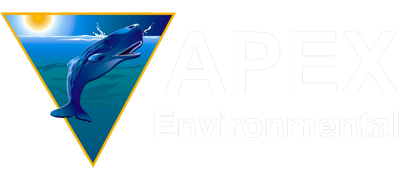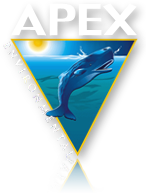Threats to Indonesia’s cetaceans
Cetaceans are long-lived marine mammals dependent on the long-term health of marine resources. Their ecology, longevity, mobility and sensitivity to chemical and acoustic disturbances make cetaceans appropriate indicators for acute as well as chronic marine environmental impacts.Cetaceans are vulnerable to numerous regional and local environmental impacts such as habitat destruction, subsurface noise disturbances, net entanglement, marine pollution and over fishing of marine resources (Hofman, 1995). Most, if not all, of these impacts may occur in the waters of Indonesia. These impacts would affect residential populations as well as transient species that include these waters in their long-range movements.
| . | |||
| Habitat destruction – Forest logging | |||
| Habitat destruction – Coastal development | |||
| Chemical pollution – Industrial and urban wastes, terrestrial run-off | |||
| Chemical pollution – The discharge of mining wastes as sea. The disposal of toxins via a procedure termed submarine tailings placement (STP) is of special relevance to Indonesian marine life. | |||
| Acoustic pollution – Destructive fishing practices such as reef bombing. This illegal fishing method can have regional impacts, especially when done in the vicinity of sensitive marine areas for cetaceans such as preferred feeding and breeding areas as well as migration passages. | |||
| Acoustic pollution – Seismic surveying for oil and gas by off-shore industries. | |||
| Acoustic pollution – Military and scientific experiments | |||
| Gill netting in sensitive marine areas for cetaceans. | |||
| Traditional hunting, especially in the waters of the East Flores islands. | |||
| Discarded plastics and fishing gear. | |||
| By-catch in local and regional fisheries. | |||
Submarine Tailings Placements (STP) – Toxic waste disposal at sea:
Coastal gold and copper mining activities use STP (Submarine Tailings Placement) as their main waste disposal procedure. This practice of dumping treated cyanide wastes into the ocean via pipes is of special relevance to Indonesia, where strong currents and complex ocean topography result in uncontrolled transport of toxic wastes and potential contamination of marine resources.
Current as well as anticipated environmental and socio-economic impacts of submarine tailings placement (STP) mining activities in Indonesia are (complete version is available as a PDF download – STP and Cetaceans.pdf – 166 Kb):
| I. | In a region as oceanographically complex as Indonesia, and especially Northern Sulawesi, the argument that any assumed marine thermocline could act as an effective barrier against vertical waste transport is not realistic. |
|
II.
|
Waste and toxin re-suspension to surface through biological vectors.
|
|
III.
|
The economical risk to local and export fisheries.
|
|
IV.
|
The increased human health risks.
|
|
V.
|
The impact of inappropriate mining procedures such as STP on numerous other important socio-economic and environmental factors, ranging from additional mining activities by opportunistic individuals to reduced tourism potential.
|
|
VI.
|
The habitat degradation of meso and bathypelagic oceanic ecosystems.
|
|
VII.
|
Major STP operational risks.
|
Local ‘wall’ and gill nets have previously been deliberately placed in marine life migration passages to maximize their efficiency. This can result in high by-catches of cetaceans and other large migratory marine species in a short time span, as demonstrated in some parts of eastern Indonesia.
Destructive fishing practices:
A major acoustic threat to cetaceans is reef bombing, a destructive fishing method commonly used in regional Indonesia and other remote parts of South-East Asia. Reef bombing can result in numerous impacts on cetaceans including:
1. Fatal exposure to high pressure waves resulting from blast.
2. Permanently reduced sensory capabilities due to non-fatal exposure to high pressure waves resulting from blast.
3. Acoustic masking of environmental cues.
4. Long-term abandonment of important habitats.
5. Long-term alteration of migration routes.
Cetaceans are especially sensitive to acoustic disturbances and local bombing practices may further restrict the already limited passage options available. This would result in significant detours from known routes and increased risk for cetaceans and other migratory marine life affected by major acoustic disturbances.
Seismic surveying for oil and gas by off-shore industries:
Marine geological surveys use blasts of high energy sounds to produce seismic waves in the ocean floor and interpret data on bottom topography and potential oil and gas field. . Seismic exploration blasts can be detected hundreds of kilometers from the source and oceanic cetaceans such as sperm whales have been seen to evacuate an area within 50 km away from the disturbance and blasts have affected cetacean acoustic behaviour up to 300 km away from the emitting source.
Recent advances in drilling technology and geo-stationary vessels allow the off-shore industry to explore for oil and gas close to 3000m deep. This rapidly expanding industry will increase its activities off the continental shelf and into oceanic areas. This will mean more of cetacean species living in the open ocean will be affected by acoustic pollution from both seismic surveys and off-shore exploitation.
Military and scientific experiments:
Of particular concern are two experiments,
Low Frequency Active Sonar (LFAS) is a military device developed to detect increasingly silent submarines at great distances. This sonar produces an high energy signal of 100-500Hz for up to 6-100 seconds in duration. Testing of LFAS has been associated with several rare multi-species strandings, especially in Greece and the Bahamas, and there is wide spread concern over the potentially fatal acoustic impact of LFAS on cetaceans in the wider region of deployment. As a result, legal actions are taken to halt further LFAS activities in Hawaii waters, and the USA Navy has voluntarily stopped further testing planned in the North Atlantic.
Marine scientists also deploy sound sources to investigate their interests. Of particular concern is the Acoustic Thermometry of Ocean Climate (ATOC). This project generates extremely loud low frequency noise that can be detected hundreds or even thousands of kilometers away from the acoustic point source. The effects of this activity on cetaceans has not been studied adequately and scientists are divided on the level of disturbance ATOC has on marine life.
For more information on Indonesia’s cetaceans download any one of these files (Acrobat Reader 4.0 PDF)
 |
|



